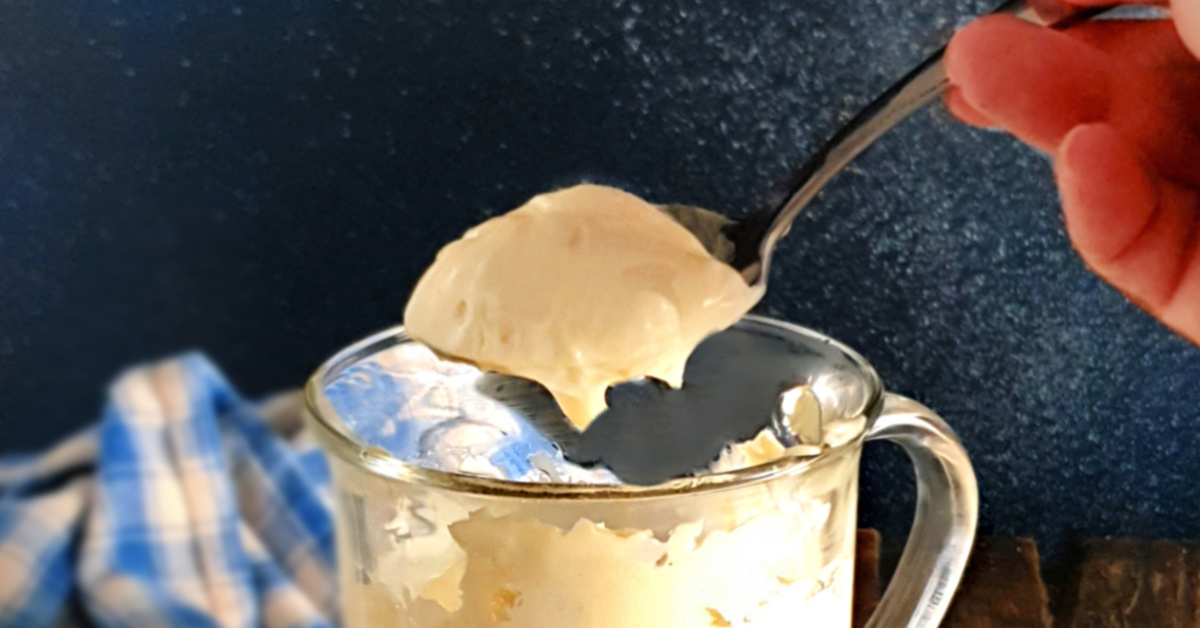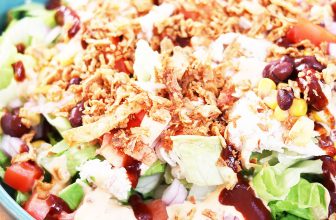
There’s just something about homemade mayonnaise — it’s fresh, rich, creamy, and tastes like it came straight from a fancy café instead of your own kitchen. Once you’ve made Mason Jar Mayonnaise using a stick (emulsion) blender, the store-bought stuff just won’t cut it.
Homemade Mayo is surprisingly easy: A handful of ingredients, a minute of blending, and just like magic, you’ve got mayo. But not just any old mayo; this is a concoction that’s so silky and flavorful, it’s going to elevate everything you use it in or on.
Warning: Long article – use the Jump to Recipe button above if you don’t care to read.
About Mason Jar Mayonnaise:
So why make Mason Jar Mayonnaise (besides the fabulous fresh taste)? For one, everything about it is under your control, as long as you’re following the basic recipe.
The type of oil, the salt type and content, and the flavorings chosen are all up to you, and you will be able to pronounce each ingredient. (I picked up a jar of Mayo at the store the other day, and there were 23 ingredients!! I had to pull out my “cheater” glasses to read everything crammed on the back of the jar!)
The recipe below makes about 1 1/2 cups (almost 13 ounces) for 85 cents using basic ingredients (priced at Lidl, November 2025). At Lidl, a comparable amount of Dukes is $2.16, Hellmann’s in a jar is $2.59, and in a squeeze bottle, $4.96.
Using higher-end ingredients (different oil choices, organic eggs) to make your homemade mayonnaise will be a bit more, but won’t be anywhere near the outrageous prices of what you buy off the shelf.
Making Mason Jar Mayonnaise:
The recipe for Mason Jar Mayonnaise has gone viral on TikTok and Instagram, and I’m psyched so many people are taking the plunge and making their own. The downside is that the content creators can’t tell you everything you need to know about Mason Jar Mayonnaise in 30 seconds to a minute! So here goes:
For best results, use room-temperature ingredients; however, don’t leave eggs out of the fridge for more than two hours. (To quickly take the chill off an egg, place it in a bowl of comfortably warm water for about 10 minutes.)
It should go w/o saying, make sure your stick blender fits in the Mason jar. The jar should be slightly wider than the blending mechanism when the blender is inserted to the bottom. The mayo won’t work if the egg is spread thinly across a wider surface area.
This is whole egg mayo, and whole works in this recipe because the egg gives enough volume for the stick blender to catch it in the tines and blend. (Classic mayo uses yolks only.)
The key to this recipe is that the egg sits at the bottom of the jar with the mustard and vinegar (or lemon juice) and a pinch of salt, while the oil floats on top.
- After everything is added to the jar except the oil, slowly add the oil (try not to disturb the egg mixture on the bottom). Let it sit for a minute or two so the oil floats in a layer at the top.
- What isn’t always evident in videos is that the egg mixture needs to be blended first. The lecithin in the egg yolk, once whipped, allows the egg (the acidic ingredients help ) to mix with the oil.
- Insert the blender all the way to the bottom right on top of the egg before turning on the blender. Holding tight to the bottom, turn it on. (Stick blenders are powerful; I use the low setting.)
- Be patient – don’t move the blender right away. It will blend up the egg mixture first, then begin to slowly suck in the oil. Let it do its thing.
- In about 10 seconds, you’ll see the mayonnaise begin to form. Once most of the oil is incorporated, around 30 seconds, very slowly bring the stick blender up bit by bit, leaving for a second or two each time it’s lifted so the rest of the oil is mixed in. If necessary, work the stick blender up and down a few times.
- Stop as soon as it’s mixed – overmixing can cause the Mayo to break and separate.
Check out this video by 12 Tomatoes; it’s one of the better ones I’ve watched, but it’s still worthwhile to read my notes above. Especially important is to let your mixture sit for just a minute before blending so the oil floats to the top.
Saving Failed Mason Jar Mayonnaise:
Sometimes, homemade Mayonnaise fails for seemingly no reason, although cold ingredients or adding oil too fast are often cited. If your mayonnaise fails, usually it can be saved, and if not, repurposed.
- 2nd Chance: Start with a fresh jar. Add in an egg yolk or two. Mix it up with the stick blender (clean it off first), then slowly, in small amounts, add the failed mayo mixture. With a little luck, it will come together.
- Repurpose: If all else fails, make Caesar salad dressing. Add a dash or two of Worcestershire sauce, a little minced garlic or garlic powder, and finely grated Parmesan cheese.
The Basic Ingredients and Flavorings:
The fun part of making homemade mayonnaise is playing with the ingredients. My favorite proportions are in the recipe, but taste and make notes for anything you’d like to change in the future to suit your tastes.
- The Eggs: Room-temperature eggs are essential to making a good mayonnaise.
- The Acid: Either vinegar or lemon adds an acidic touch, but also adds flavor and helps with the emulsion. Choose which to use and how much. Make your Mayo punchier by increasing the amount. Choose a flavored vinegar if you wish
- The Mustard: Dijon is the standard, but any prepared mustard may be used, the amount adjusted to your taste. Mustard powder is fairly neutral.
- Salt and/or Sugar: Either or both can be added to taste.
- Oil: A neutral-tasting oil is the standard. Different oils will affect not only the taste, but also how well the mayonnaise emulsifies.
Beyond the Basic Flavors:
What will you add for a standout Mayonnaise?
- Classic flavor additions are lemon zest, tarragon, or dill, but almost any herb or blend of your choosing will work. Think Italian, Cajun, and so on. Check out my favorite Seasoning Blends for inspiration.
- Roasted garlic is awesome (don’t keep the mayo over five days if using raw garlic).
- Powdered Ranch Mix can be added for Ranch Mayo, or use this Mayo for the best Buttermilk Ranch Dressing. Directions in the linked post.
- Chipotle peppers (or any chile powder), combined with lime (instead of the lemon or vinegar), are fabulous. For another smoky option, think smoked paprika.
- Bacon drippings for all or part of the oil will add a rich, smoky flavor.
- Consider Horseradish or Wasabi for a flavor kick.
- For Miracle Whip, add sugar, garlic powder, and a touch of paprika.
- Check out commercial mixtures, aoilis, sandwich spreads, and sauces based on mayo for more flavor inspiration.
- Maybe you’ll want to mimic your favorite restaurant’s “secret sauce.” Homemade mayo will make a marvelous starting point.
Mayo-Based Recipes You Might Like:
Storing Homemade Mayonnaise:
- Homemade Mayonnaise must be stored in the refrigerator (the coldest part) in an airtight container.
- If using raw eggs, keep for three to five days. If using pasteurized eggs, it may be kept up to two weeks. Some additional ingredients will call for shorter storage times; see Beyond Basic Flavors.
- If the Mayonnaise develops a sour or off smell, changes color, or shows signs of mold, discard. If it tastes strange, discard. If it becomes watery when stored, discard.
- If the Mayonnaise becomes too thick after refrigerating, this is not an indication of a potential safety risk. Give it a stir, and if still too thick, add warm water by the teaspoon, stirring well after each addition. Stop when the desired texture is reached.
- Do not freeze Homemade Mayonnaise.
Concerns about Homemade Mayonnaise:
It’s important to follow good food safety practices when making and storing homemade mayonnaise. There is always a very slight risk of contamination when consuming undercooked or raw eggs, but there are ways to minimize that risk.
- Be Clean: The cleaner you work, the better. Wash your hands and any equipment you are using well to avoid adding any contaminants.
- Use High-Quality Eggs: Use high-quality eggs that have been stored properly and avoid those with cracked or damaged shells.
- Don’t Wash the Eggs: Egg shells are porous, and washing can drive any possible contamination from the outside of the shell to the interior of the egg.
- Consider Pasteurized Eggs: If there is a concern about raw eggs (infants, the elderly, immunodeficient individuals, and those who can’t stomach the idea), consider using pasteurized eggs.
- Home Pasteurized Eggs: According to the FDA and USDA, there is no safe way to pasteurize eggs at home, despite anecdotal information on the net. Doing so may simply place the eggs longer in the “danger zone” between 40 and 140 degrees F.
- Add Acid: Lemon juice (or lime juice) or vinegar, and to a lesser extent, prepared mustard, increases acidity (lowers the PH level), which may inhibit bacterial growth. These ingredients add flavor and help to emulsify the mayonnaise, too.
- Add Salt and/or Sugar: Either salt or sugar, in addition to acidic ingredients, may help to create a hostile environment for bacteria.
Saving Money on Groceries:
What you pay for groceries depends on not just WHERE you shop, but WHEN. Be strategic and stock up at rock-bottom prices.
- The best sales are before holidays; check out Win at the Grocers. Think beyond the occasion & use the opportunity to stock up at a low for the coming weeks to months.
- If available, take advantage of discount stores like Aldi or Lidl. The pricing at Buyer’s clubs is not always the lowest, but can trump in quality. Be selective when shopping there.
The best way to save money on this or any recipe is to have a well-stocked pantry, fridge, and freezer full of sale-priced items.
Eggs:
- Both Aldi & Lidl, as well as buyer’s clubs (you will need to buy larger amounts at the buyer’s club), have great everyday prices, but usually do not approach a great pre-holiday grocery store sales price.
- If you have room, stock up at a low. Eggs, according to the National Egg Board, keep well for 4 to 5 weeks after the pack date, usually about 3 weeks after buying.
- Don’t store in the door; keep in original package on a bottom shelf in the fridge.
Oil:
- Use a neutral-flavored oil, anything you’re comfortable with. Vegetable oil works well, so bonus for being cheap.
- Shop well for healthier and/or pricier oils. Buyer’s Clubs have surprising pricing and quality. Discount stores like Aldi & Lidl have good pricing and a decent selection. At the regular grocery, watch for sales, especially on new items. If there’s a discount tag, remove it and hand it to the clerk. They’re often missed.
I hope you found the information here on Homemade Mayonnaise useful. There’s a lot to cover for something so simple. Enjoy, and I hope to see you here next time.
Mollie
Mason Jar Mayonnaise
- Prep Time: 5 minutes
- Total Time: 5 minutes
- Yield: 1 1/2 cups 1x
- Category: Condiments
- Cuisine: French
- 1 large or extra-large egg, room temperature
- 1 teaspoon Dijon mustard
- 1 tablespoon lemon juice or white wine vinegar
- 1/2 teaspoon salt
- 3/4 to 1 cup neutral oil
Add the egg, mustard, lemon juice or vinegar, and salt to the bottom of a mason jar. Slowly pour in oil. Allow to sit for a minute until the oil is floating on top.
Place the stick blender directly over the egg and tight to the bottom of the jar. Turn on and hold in place for about 30 seconds, or until most of the oil is incorporated.
Slowly lift, bit by bit, to blend in any remaining oil. If necessary, work the blender up and down in the jar a time or two. Do not overblend.
Keep for up to five days in the coldest part of the fridge; if using pasteurized eggs, keep up to two weeks.















